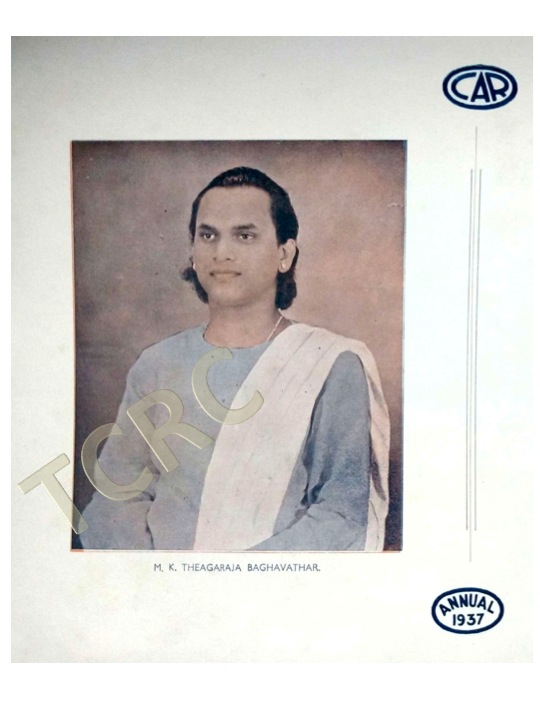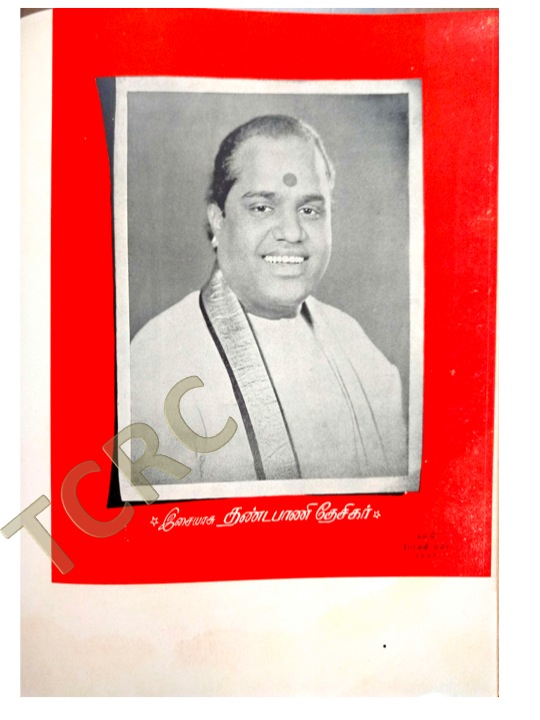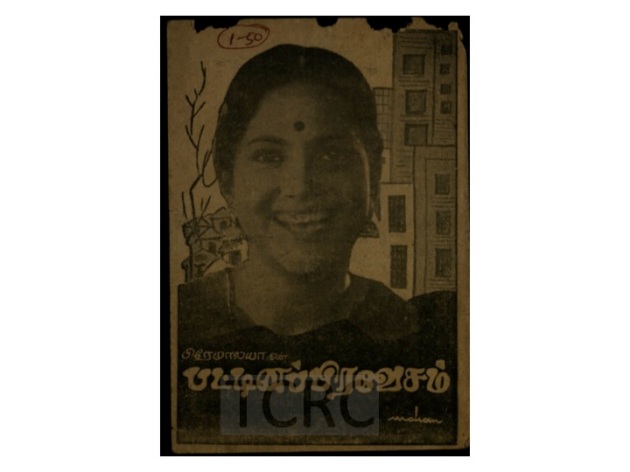By P.V.Gopalakrishnan
4) Moon in ‘Happy hour’: “Aaha inba nilavinile” from ‘Maya Bazaar’ (1957)

Song book of Maya Bazaar PC: From the archives of TCRC
“Aaha inba nilavinile” was a lilting number from the Magnum Opus, ‘Maya Bazaar’ in the music of Ghantasala, filmed on Savitri as Vatsala & Gemini Ganesan as Abhimanyu, as they row their decorated boat in the serene waters of Ennore lake. This scene is highlighted by blissful music of Ghantasala (duet rendered by P.Leela & Ghantasala) & the raving cinematography of Marcus Bartley.
This evergreen song was actually shot by him at noon on Ennore lake and you can see, with the limited technology of those times, how they could create the illusion of pleasing moonlight!
The first mythological film produced by their studio, Maya bazaar marked a milestone for Nagi Reddy and Chakrapani. In addition to the technical crew, 400 studio workers – including light men, carpenters, and painters – participated in the development of the film. The film is considered a landmark cinema, with praise for its cast and technical aspects, despite the limitations of technology at the time.
5) Moon as an Arbitrator: ‘Varayo vennilave” from ‘Missiyamma’ (1955)
Another unique situation where both the hero & heroine address their complaints to the supreme Moon, thereby letting their thoughts known to each other without direct interaction has been picturised on the voices of A.M.Raja & P.Leela in Vijaya Productions’ “Missiyamma’.
The lead pair of this blockbuster constituted Savithri & Gemini Ganesh. Originally the female lead was to be done by Bhanumathi with whom some shoot was done. But owing to some misunderstanding the producers replaced her with Savithri. A trivia associated with this movie, as per Mr.Narasimham in his Article in The Hindu of October 2014, goes like this: “While watching the Missiyamma at Roxy theatre in Madras in 1955, a woman gave birth to a baby girl in the theatre. The mother and child were rushed to the hospital, where the baby was named Missiyamma by her parents.”
6) Moon as a spinster sees it: ‘Amudhai pozhiyum nilave’ in ‘Thangamalai Ragasiyam’ (1957)
This beautiful solo, in the fresh & pristine voice of P.Suseela, was composed by T.G.Lingappa for the film ‘Thangamalai Ragasiyam’ & picturised on the pretty Jamuna as she wonders as to why the Moon could not descend & come proximate to her, as she sings by the studio pond.
This film had Sivaji Ganesan playing a Tarzan like role, growing up as a ferocious caveman till he meets the petite Jamuna, who turns him into civility.
7) Moon in separation times : “Idhaya vaanin udaya nilave” from “Vanjikottai Valiban’ (1958)
This is a pathos number, nevertheless very melodious, whereby both the separated heroine & hero sing to the Moon declaring their separation vows. Amazing music composition by Vedha who has deployed Vibrafone, Piano, Violins & Flute to touching effect on the listeners’ soul.
The lyrics of the subject song were of Vindhan.
8) Moon in times of ecstasy: “Aghaya veethiyil azhagana vennila” from ‘Manjal Magimai’ (1959)
This is a joyous situation where both the Hero & Heroine are together & are enjoying the beauty of a full moon . The voices were P.Suseela & Ghantasala & the music score was by Master Venu. The song features Pipofone & Univox organ which is the forefather of the modern synthesizers.
9) Moon in lighter moments: “Nilavum malarum paduthu” from “Then Nilavu’ (1960)
A boat ride by Gemini Ganesan & Vyjayanthimala in the serene waters of Dal lake in Kashmir, lip-syncing to a duet voiced by A.M Raja & P.Suseela, features in this visual. The song refers to the Moon & the Flower in concert to describe the pair’s romantic overture, as the serene tune by the Music Director A.M.Raja is soothing with Hawaiian-Guitar notes & serenading violins.
10) Moon’s dilemma: “Athi kaay kaay..kaay” from ‘Bale Pandiya’ (1962)
This Moon scene features two pairs of lovers appealing individually to the Moon whereby each pair urges that the Moon shines on the other person. This is another unique situation with a tinge of Lucknowi tradition of “pehle aap”! Again, a studio moon but this time meeting the pairs involved, as they plead her to shine on the other. Quite a quandary for the Moon as to whereupon to shine, indeed!
The lyrics of this song is a great master piece by the legend Kannadasan, as the names of fruits & vegetables have cleverly been used in the lyrics to convey different interpretations through the song.
11) Moon as witness to pathos: “Nilave ennidam nerungathe” from ‘Ramu’ (1966)
A beautiful composition in the Raga Bagheshri, this song has become an iconic one. Filmed in a sequence where the hero warns the Moon not to near him as he was in a dilapidated state of mind. This situation is in complete contrary to what the heroine of ‘Thangamalai Rahasiyam’ desired, where she invited the Moon to come proximate to her! This shows that the Moon was omnipresent in every unique situation like love, courtship, separation, dispute resolution, frustration and what not, in various movies.
This song, from the film ‘Ramu’ music scored by MSV, is a cult song, liked by all owing to its classical base as well as impeccable rendering by P.B.Srinivas in his sonorous voice timbre. Incidentally, this was also the song that SPB sang before MSV when he was first auditioned him! By the by, this writer came across an Article, ”The song and its sweep”, by Rangnath Nandyal in The Hindu dated 20.6.13 that this song was composed by Telugu Composer Pendyala for the Telugu version of the film.
12) Moon listening to a decree: “Paal polave vaan meedhile” from ‘Uyarntha manithan’ (1968)
In this song song “Paal Polave”, the picturisation is about a Nayika who is suffering solitude due to her Nayaka being away & thereby ordaining the Moon to vacate seat & return the next day, when she would be united with her love. This sequence has been borrowed from early Tamil literature. Another unique occasion for a Moon song, indeed!
The filming of this song sequence, originally scheduled to be shot at Kodaikanal, had to be called off due to weather conditions. However, Art Director, A. K. Sekhar, constructed a special set at AVM studios, that mimicked the misty ambience of Kodaikanal, and the song was picturised in this set.
This was an award winning song as it won the National Film Award for Best Female Playback Singer for P. Susheela, making it the first Tamil film to win a National Award under that category.
‘Uyarndha manithan’ was produced by A. V. Meiyappan under AVM Productions and had the legend Sivaji Ganesan (his 125th movie) and Sowcar Janaki in the lead roles. The film was written by Javar Seetharaman, based on Bengali fim ‘Uttar Purush’ and directed by the noted duo Krishnan–Panju, who had directed over fifty films in South Indian languages and Hindi.
We have seen, as detailed above, as to how the Tamil screen was obsessed with Moon in various emotive scenes. And they had their magic effect with alluring songs that accompanied them on screen. But times have changed & the Moon has disappeared from the silver screens, only to occasionally show itself up in movies, in rarity!

















